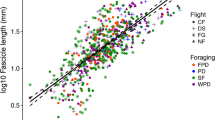Summary
-
1.
Evoked potentials (EPs) and single unit recordings from various electrosensory-processing regions of several pulse-type gymnotiform species were made to investigate neural activity patterns that could be associated with novelty detection.
-
2.
Whereas the electrosensory afferents and cells in the ELL exhibited only minor changes in response size as stimuli were presented less frequently (novel stimuli), most units studied in the torus semicircularis (TS) showed very strong, increased responsiveness to stimuli presented less frequently relative to stimuli presented persistently (at every EOD event: Figs. 1, 2).
-
3.
The responses of the TS were graded with respect to stimulus frequency (Fig. 3). The discrimination between novel and persistent stimuli by the TS occurred with stimuli presented transversely or longitudinally with respect to the fish's long axis, and regardless of the timing of the stimulus with respect to the fish's pacemaker-related signal (PS). When electrosensory novelties were presented persistently the responses of the TS rapidly habituated (Fig. 4). This may indicate that activity in this region of the TS is novelty related.
-
4.
This novelty-related activity in the TS can be correlated with certain aspects of the fish's behavior, i.e., EOD interval length during a behavioral novelty response (Fig. 5). However, TS activity may continue to indicate the occurrence of electrosensory novelties after the behavior has habituated.
-
5.
It is suggested that the novelty-related activity of the TS of these fish is necessary, but not sufficient, for the production of electrosensory novelty-induced behavioral responses. Lesions of the region of the TS containing the rapidly-habituating neurons abolished the electrosensory novelty response, but not that resulting from visual and auditory stimulation.
Similar content being viewed by others
Abbreviations
- EOD :
-
Electric organ discharge
- PS :
-
Pacemakerrelated signal
- EP :
-
Evoked potential
- ELL :
-
Electrosensory lateral line lobe
- EGP :
-
Eminentia granularies posterior
- LC :
-
Lobus caudalis
- TS :
-
Torus semicircularis
References
Baker CL jr (1980) Jamming avoidance behavior in gymnotoid electric fish with pulse-type discharges: sensory encoding for a temporal pattern discrimination. J Comp Physiol 136:165–181
Baker CL jr (1981) Sensory control of pacemaker acceleration and deceleration in gymnotiform electric fish with pulse-type discharges. J Comp Physiol 141:197–206
Carr CE, Maler L, Heiligenberg W, Sas E (1981) Laminar organization of the afferent and efferent systems of the torus semicircularis of gymnotiform fish: morphological substrates for parallel processing in the electrosensory system. J Comp Neurol 203:649–670
Grau HJ (1985) The novelty response of pulse-type weakly electric fish: a neuroethological study. PhD thesis, University of Oklahoma
Hagiwara S, Morita H (1963) Coding mechanisms of electroreceptor fibers in some electric fish. J Neurophysiol 26:551–567
Heiligenberg W (1980) The evaluation of electroreceptive feedback in a gymnotid fish with a pulse-type electric organ discharge. J Comp Phyiol 138:173–185
Heiligenberg W, Baker C, Bastian J (1978) The jamming avoidance response in gymnotoid pulse-species: a mechanism to minimize the probability of pulse-train coincidence. J Comp Physiol 124:211–224
Hopkins C, Heiligenberg W (1978) Evolutionary designs for electric signals and electroreceptors in gymnotoid fishes of Surinam. Behav Ecol Sociobiol 3:113–134
Larimer JL, MacDonald JA (1968) Sensory feedback from electroreceptors to electromotor pacemaker centers in gymnotids. Am J Physiol 214:1253–1261
Lissman HW (1961) Ecological studies on gymnotids. In: Chagas C, Paes de Carvalho A (eds) Bioelectrogenesis: a comparative survey of its mechanisms with particular emphasis on electric fishes. Elsevier, New York, pp 215–226
Maler L (1979) The posterior lateral line lobe of certain gymnotoid fish: quantitative light microscopy. J Comp Neurol 183:323–345
Schlegel PA (1977) Electroreceptive single units in the mesencephalic magnocellular nucleus of the weakly electric fishGymnotus carapo. Exp Brain Res 29:201–218
Suga N (1967) Coding in tuberous and ampullary organs of a gymnotid electric fish. J Comp Neurol 131:437–452
Szabo T, Sakata H, Ravaille M (1975) An electrotonically coupled pathway in the central nervous system of some teleost fish, Gymnotidae and Mormyridae. Brain Res 95:459–474
Westby GWM (1975) Has the latency dependent response ofGymnotus carapo to discharge-triggered stimuli a bearing on electric fish communication? J Comp Physiol 96:307–341
Author information
Authors and Affiliations
Rights and permissions
About this article
Cite this article
Grau, H.J., Bastian, J. Neural correlates of novelty detection in pulse-type weakly electric fish. J. Comp. Physiol. 159, 191–200 (1986). https://doi.org/10.1007/BF00612302
Accepted:
Issue Date:
DOI: https://doi.org/10.1007/BF00612302




